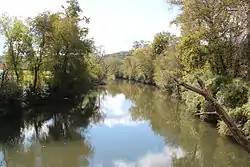Coosawattee River
The Coosawattee River is a 49.3-mile-long (79.3 km)[2] river located in the northwestern Georgia, United States.[1]
| Coosawattee River | |
|---|---|
 | |
| Location | |
| Country | United States |
| State | Georgia |
| County | Gilmer, Gordon, & Murray |
| Physical characteristics | |
| Source | confluence of the Ellijay and Cartecay rivers |
| • location | Ellajay |
| • coordinates | 34.6914744°N 84.4835388°W[1] |
| • elevation | 575 ft (175 m)[2] |
| Mouth | Oostanaula River |
• location | at Carters Lake |
• coordinates | 34.6050863°N 84.6332661°W[1] |
• elevation | 1,073 ft (327 m)[1] |
| Length | 49.3 mi (79.3 km)[2] |
| Basin features | |
| Tributaries | |
| • left | Coley Creek, Harris Creek, Camp Branch, Lewis Branch, Camp Branch, Talking Rock Creek, Duke Creek, Dry Creek, Salacoa Creek, and Crane Eater Creek |
| • right | Mountaintown Creek, Tails Creek, Goble Branch, Woodring Branch, Fisher Creek, Willbanks Branch, Mineral Springs Branch, Rock Springs Branch, Sugar Branch, Noblet Creek, Dry Creek, and Vanns Creek |
Description

The river is noted as beginning at the confluence of the Ellijay and Cartecay rivers in the city of Ellijay in central Gilmer County. The river flows west through the foothills in the North Georgia mountains region and is a tributary of the Oostanaula River (It in turn is a tributary of the Coosa River). Primary tributaries of the Cooswattee River include Mountaintown Creek, Tails Creek, Cole Creek, Goble Branch, Harris Creek, Camp Branch, Lewis Branch, Woodring Branch, Fisher Creek, Talking Rock Creek, Willbanks Branch, Mineral Springs Branch, Rock Springs Branch, Sugar Branch, Duke Creek, Noblet Creek, Dry Creek, Salacoa Creek, Vanns Creek, and Crane Eater Creek
In Murray County, the river is impounded by Carters Dam, forming Carters Lake behind the dam. (The lake is located mostly in Gilmer County). Completed in 1977, Carters Dam is the tallest earthen dam east of the Mississippi River.[3] The Coosawattee River leaves the dam flowing west (directly into the Reregulation Reservoir). It serves as the Murray-Gordon County line before entering Gordon County.
Near New Echota, a late capital of the Cherokee Nation (1794-1907 before removal in 1838, the Coosawattee meets the Conasauga River. They form the Oostanaula River, a tributary of the Coosa River.[4]
This area was the center of Cherokee Nation territory in north Georgia and southeastern Tennessee. In the early 1820s, after having migrated from eastern Tennessee after being forced by the United States to cede their lands there, they made New Echota their capital.
In popular culture
American writer James Dickey used the Coosawattee River as the basis of his fictional "Cahulawassee River" in his debut novel, Deliverance (1970).[5][6][7] It was adapted as a 1972 feature film of the same name, directed by John Boorman.
See also
- List of rivers in Georgia (U.S. state)
References
- U.S. Geological Survey Geographic Names Information System: Coosawattee River
- U.S. Geological Survey. National Hydrography Dataset high-resolution flowline data. The National Map Archived 2016-06-30 at the Wayback Machine, accessed April 27, 2011
- "Carters Lake". US Army Corps of Engineers, Mobile District. United States Army Corps of Engineers. Retrieved 15 December 2015.
- Krakow, Kenneth K. (1975). Georgia Place-Names: Their History and Origins (PDF). Macon, Georgia: Winship Press. p. 51. ISBN 0-915430-00-2.
- Gatling, William (2010-06-30). "Deliverance and the Coosawattee". Georgia Canoeing Association. Retrieved 2020-09-29.
- "Filming Locations for Deliverance (1972), in Georgia". The Worldwide Guide to Movie Locations. Retrieved 2020-09-29.
- "Brown's Guide to Georgia". web.archive.org. 2010-12-22. Retrieved 2020-09-29.
External links
![]() Media related to Coosawattee River at Wikimedia Commons
Media related to Coosawattee River at Wikimedia Commons
